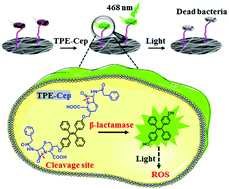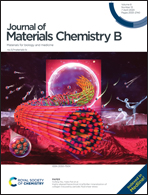Fibrous testing papers for fluorescence trace sensing and photodynamic destruction of antibiotic-resistant bacteria
Abstract
The increasing prevalence of antibiotic-resistant bacteria needs rapid identification and efficient destruction routes. This study proposes testing paper derived from electrospun fibrous mats and aggregation-induced emission (AIE) probes for trace sensing and simultaneous destruction of antibiotic-resistant E. coli. Aptamers are conjugated on fibers for selective capture of E. coli, and the capture capability can be regenerated via rinsing with salt solution. Hydroxyl tetraphenylethene (TPE) is linked with two cephalosporin molecules to construct TPE-Cep probes, and the fluorescence emission is turned on specifically in the presence of β-lactamase, which is a critical marker for screening resistant bacteria. Fibrous mats are lit up only in the presence of antibiotic-resistant bacteria, and the fluorescence intensity changes could be statistically fitted into an equation for quantitative analysis. Fibrous strips display apparent color changes from blue to green for a visual readout of bacterial levels, and the limit of detection (LOD) is much lower than those of previous paper substrates. In addition, the TPE-Cep probes could produce reactive oxygen species (ROS) under room light illumination to kill the captured bacteria. Thus, the integration of aptamer-grafted electrospun fibers and functional AIE probes provides potential for selective capture, trace imaging and photodynamic destruction of antibiotic-resistant bacteria.



 Please wait while we load your content...
Please wait while we load your content...